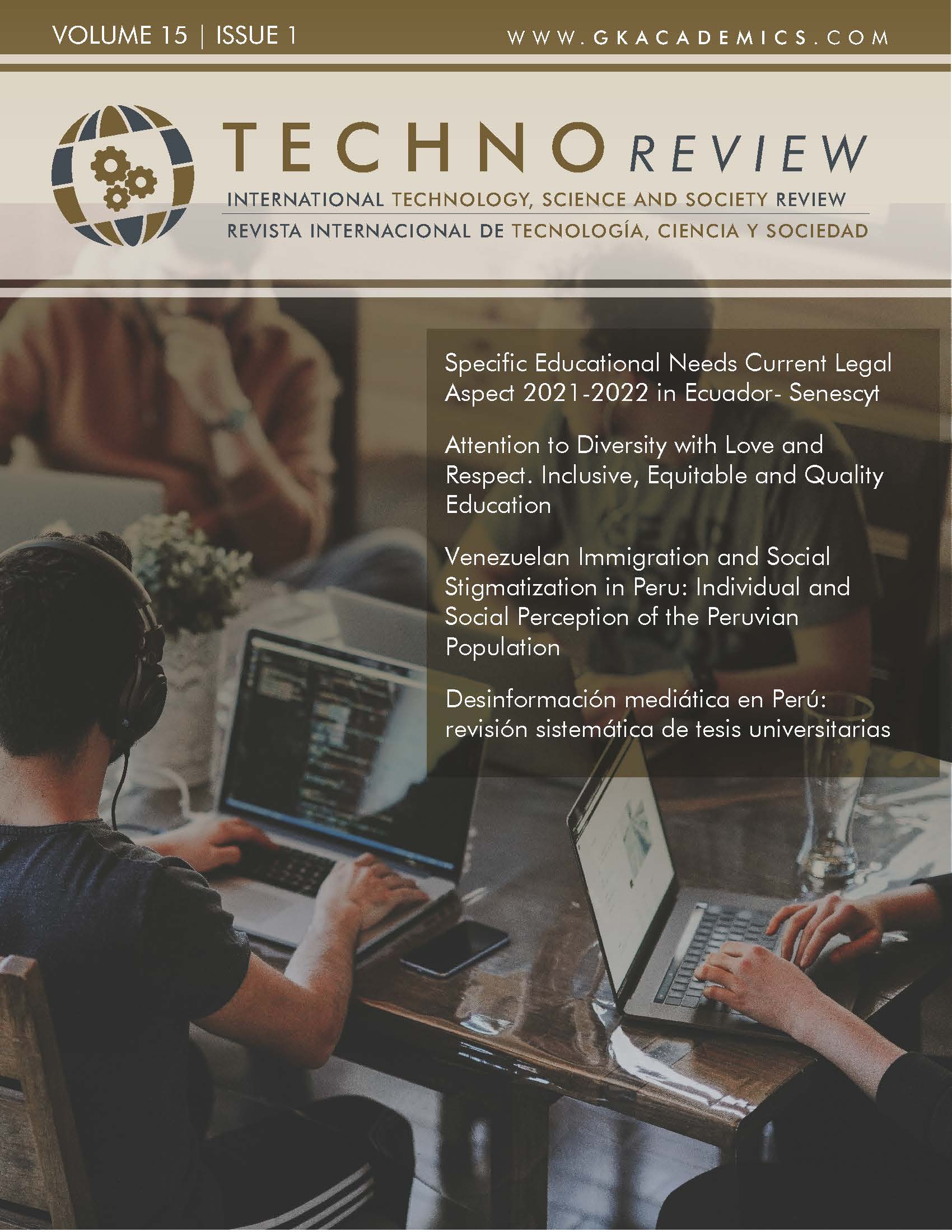Applicability of Emerging Technologies in Virtual Learning Environments. A look at the University of Guayaquil
DOI:
https://doi.org/10.37467/revtechno.v15.5098Keywords:
emerging technologies, virtual learning environments, remote teaching, artificial intelligenceAbstract
The objective of the study was to determine the applicability given by teachers of the University of Guayaquil to emerging technologies in virtual learning environments. It assumed the quantitative approach, descriptive type of research, and field design, non-experimental, cross-sectional. It was conducted during the second period of 2022. The population under study was 287 teachers of the Faculty of Philosophy, Letters and Educational Sciences, the sample consisted of 166 teachers after applying a simple random sampling.
References
Aguirre-Herráez, R. G., Guevara-Vizcaíno, C. F., Erazo-Alvarez, J. C., & García-Herrera, D. G. (2020). Augmented reality and education in Ecuador. Revista Arbitrada Interdisciplinaria Koinonía, 5(5), 415-438.
Alonso-Arévalo, J., & Quinde-Cordero, M. (2023). ChatGPT: The automatic creation of academic texts with Artificial Intelligence and its impact on academic and educational communication. Desiderata, 6(22), 136-142.
Angulo, R. J., Mesías, A., & Olmedo (2021). Impact of new technologies on university education in Ecuador. Qualitas Magazine, 23(23), 12-21. https://doi.org/https://doi.org/10.55867/qual23.02
Barranco, V. E. (2023). Prototype for e-learning on mobile devices for English subject. Revista Lengua y Cultura, 4(8), 106-111.
Cantuña Avila, A. A., & Cañar Tapia, C. E. (2020). Systematic review of the flipped classroom in Ecuador: approximation to the state of the art. Estudios pedagógicos (Valdivia), 46(3), 45-58. https://doi.org/10.4067/S0718-07052020000300045
Carrera Tapia, R. D., Gavilanez Vargas, L. V., & Tenorio Barragán, S. M. (2022). Effect of virtual strategies in teaching-learning in Higher Technological level. Revista Científica y Tecnológica VICTEC, 3(5), 29-45.
De Vito, E. L. (2023). Artificial intelligence and chatGPT.Would you read an artificial author? MEDICINA (Buenos Aires), 83, 329-332.
Engel, A., & Coll, C. (2022). Hybrid teaching and learning environments to promote personalization of learning. RIED. Revista Iberoamericana de Educación a Distancia, 25(1), 225-242.
Espinosa Izquierdo, J. G., Villamar Bravo, J. E., Quijije Acosta, K., & Mesa Vazquez, J. (2023). New information and communication technologies in education. Polo del Conocimiento, 8(3), 1196-2012. https://doi.org/10.23857/pc.v8i3.5380. https://doi.org/10.23857/pc.v8i3.5380
Fajardo Pascagaza, E., & Cervantes Estrada, L. C. (2020). Modernization of virtual education and its incidence in the context of Information and Communication Technologies (ICT). Academia y Virtualidad, 13(2), 103-116. https://doi.org/https://doi.org/10.18359/ravi.4724. https://doi.org/https://doi.org/10.18359/ravi.4724
Ferreira da silva, P. (2018). Opportunities and challenges of emerging technologies The importance of the aerospace industry for Brazil. U.S. Air Force Magazine, 36-48. https://doi.org/https://www.airuniversity.af.edu/Portals/10/JOTA/Journals/Volume%201%20Issue%202/Spanish/05-peterson_s.pdf.
González, F. J., Barros, C. I., Iglesias, P., & Rugel, C. I. (2017). Analysis of the applications of the game theory in the process of strategic administration and direction of companies. Paper presented at the CISCI 2017 - Decima Sexta Conferencia Iberoamericana En Sistemas, Cibernetica e Informatica, Decimo Cuarto Simposium Iberoamericano En Educacion, Cibernetica e Informatica, SIECI 2017 - Memorias, 362-366. Retrieved from www.scopus.com
García-Peñalvo, F. J. (2023). The perception of Artificial Intelligence in educational contexts after the launch of ChatGPT: disruption or panic. Education in the Knowledge Society (EKS), 24, e31279. https://doi.org/https://doi.org/10.14201/eks.31279
Injante Oré, R. E. (2020). Method to recommend personalized positioning factors in Google search engine. Universidad Nacional Mayor de San Marcos.
Mora-Vicarioli, F., & Salazar-Blanco, K. (2019). Applicability of emergent pedagogies in e-learning. Ensayos Pedagógigos Journal, XIV(1), 125-159. https://doi.org/ dx.doi.org/10.15359/rep.14-1.6.
Moreno Mercado, S. (2022). Aportes de un Entorno Virtual de Aprendizaje en la Enseñanza en Electrocardiografía en Estudiantes de Medicina. Pilot University of Colombia.
Mousalli-Kayat, G. (2015). Quantitative Research Methods and Designs.
Murray, R. S., & Larry, J. S. (2009). Statistics. 4th edition. Mc Graw-Hill.
Olarte Ciprián, Y. M. (2023). Empowering emergent pedagogy for knowledge construction in virtual learning environments. Revista EDUCARE - UPEL-IPB - Segunda Nueva Etapa 2.0, 27(1), 420-435. https://doi.org/https://doi.org/10.46498/reduipb.v27i1.1801
Pascuas-Rengifo, Y. S., García-Quintero, J. A., & Mercado-Varela, M. A. (2020). Mobile devices in education: trends and impact for innovation. Revista Politécnica, 16(31), 97-109. https://doi.org/https://doi.org/10.33571/rpolitec.v16n31a8. https://doi.org/https://doi.org/10.33571/rpolitec.v16n31a8
Rivera Calle, F. M., & García Martínez, A. (2023). Inverted classroom with emerging technologies in virtual environments at the Salesian Polytechnic University of Ecuador. Revista Cubana De Educación Superior, 37(1 Jan-Apr).
Rocano Parrales, G. M. (2021). Educommunication in times of pandemic: Analysis of the use of Moodle and Virtual Learning Environments in secondary education in the city of Guayaquil (Master's thesis). University of Guayaquil.
Ruiz Tirado, M. F. (2022). The impact of distance education and the use of technology. Formación Estratégica, 6(2), 145-160.
Solórzano Álava, W. L., Rodríguez Rodríguez, A. A., Anzules Ávila, X. L., & Cornelio, O. M. (2022). Impact of the use of technology in the integral formation of information technology students. Journal TechInnovation, 1(2), 71-77. https://doi.org/https://doi.org/10.47230/Journal.TechInnovation.v1.n2.2022.71-77. https://doi.org/https://doi.org/10.47230/Journal.TechInnovation.v1.n2.2022.71-77
Solorzano, L., Choez, C., Castillo, J., Castillo, C. M., & Macias, A. (2023). Breaking barriers in mathematics education: how apps and technologies can improve academic performance and student confidence. RevistaG-ner@ndo, 4(1), 888-911.
Toala-Palma, J. K., Arteaga-Mera, J. L., Quintana-Loor, J. M., & Santana-Vergara, M. I. (2020). Virtual Reality as a tool for educational innovation. EPISTEME KOINONIA, 3(5), 270-286.
Uribe-Posada, R. B., Gómez-Vargas, J. M., & Hernández-Lazo, R. (2022). Virtual learning environments in teacher training at the Institución Educativa Escuela Normal Superior del municipio de San Juan del Cesar-La Guajira. Revista Criterios,,, 29(1), 38-59.
Valle-Cruz, D., & Gil-García, J. R. (2022). Emerging technologies in local governments: A systematic literature review using the PRISMA methodology. Mexican Journal of Political Analysis and Public Administration, 11(21), 9-28.
Vera, F. (2023). Integrating Artificial Intelligence in Higher Education: Challenges and opportunities. Transform, 4(1), 17-34.
Verdín Torres, E. Y. (2022). The influence of gamification in virtual learning environments. Formación Estratégica, 6(2), 34-49.
Villamar Irrazabal, M. D., Otero Agreda, O. E., & Nivela Cornejo, M. A. (2021). Changes in technology used in education over time. Horizontes Revista de Investigación en Ciencias de la Educación, 5(21), 58-71.
Yanza Chávez, W. G., & Montalvo Armijos, R. G. (2023). Incidence in the use of CAT for the teaching of programming logic with the students of First of Finance of ESPOCH. Revista Imaginario Social, 6(2). https://doi.org/https://doi.org/10.59155/is.v6i2.110. https://doi.org/https://doi.org/10.59155/is.v6i2.110

